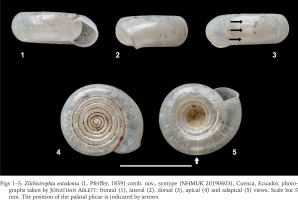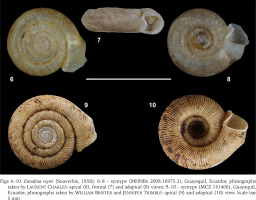INTRODUCTION
As frequently demonstrated in recent works, the taxonomy of the Neotropical snail family Scolodontidae can only be resolved by revisiting the original type material of genera and species prominently recorded in the literature (Roosen 2023, Roosen et al. 2023, Roosen & Breure 2024). For instance, four different type designations were available for Happia Bourguignat, 1890, which caused four separate scolodontid genera to be continuously confused with each other. This could only be resolved by accepting Helix ammonoceras Reeve, 1854 as the type species of Happia, by typification of the replaced name Ammonoceras Pfeiffer, 1855 (not Lamarck, 1822). As the characters of H. ammonoceras were poorly known, the species had to be redescribed along with the closely related Happia andia (Pilsbry, 1932) to provide a solid definition of Happia (Roosen & Breure 2024). In some other cases, wrongly identified species or specimens also undermined the diagnosis of several genera within the family (Roosen 2023), making the task of assigning scolodontid species to the correct genera all the more troublesome.
Helix entodonta L. Pfeiffer, 1859, described from Ecuador, is an example of a species causing major confusion in literature after several malacologists tried to interpret its characters with only limited information available. During its history, it has been assigned to three different scolodontid genera: Polygyratia Gray, 1847 (= Ophiogyra Albers, 1850), Entodina Ancey, 1887, and most often, Systrophia Pfeiffer, 1855 (Miller 1878, Pilsbry 1894, Kobelt 1905, Gude 1920, Breure et al. 2022). Though it was often included in Systrophia, the diameter of Helix entodonta at 5.7 mm is less than half that of the typical Systrophia, which often exceeds 12 mm in diameter (e.g. Breure et al. 2022). This has troubled the separation of Systrophia from small genera with a similar shape, like Zilchistrophia Weyrauch, 1960 and Entodina Ancey, 1887. Moreover, several authors noted that H. entodonta has three palatal plicae in the shell (e.g. Pfeiffer 1859a, 1859b, Gude 1920), which is a typical character for Zilchistrophia Weyrauch, 1960 (Páll-Gergely & Asami 2014).
Zilchistrophia is a genus that currently only includes five species (Páll-Gergely & Asami 2014). In the past, it was tentatively assigned to Plectopylidae or Corillidae based on its palatal plicae (Weyrauch 1960), but Ramirez (1993) and Páll-Gergely & Asami (2014) included it in Scolodontidae based on anatomical data. It is one of the few genera with known anatomy within Scolodontidae.
In this paper, we provide evidence that Helix entodonta is a member of Zilchistrophia based on a re-examination of the type material and discuss the nomenclatural implications of this decision.
MATERIAL AND METHODS
The syntypes of Helix entodonta L. Pfeiffer, 1855 were examined and photographed with a stereo microscope. The images were compared to the pictures and descriptions of Zilchistrophia in Weyrauch (1960) and Páll-Gergelly & Asami (2014), as well as to all known Ecuadorian Scolodontidae in Breure et al. (2022). Detailed images of the type species of relevant taxa were also requested to be figured out in the current paper. Specimens described or figured out in this paper are deposited in the collections of the Natural History Museum, London, United Kingdom (NHMUK), Muséum Bordeaux – Sciences et Nature (MHNBx) and The Museum of Comparative Zoology at Harvard University, Cambridge, Massachusetts, United States of America (MCZ).
SYSTEMATICS
Family Scolodontidae Baker, 1925
Genus Zilchistrophia Weyrauch, 1960
Zilchistrophia entodonta (L. Pfeiffer, 1859) comb. nov.
Figs 1–5
Zilchistrophia entodonta (L. Pfeiffer, 1859) comb. nov., syntype (NHMUK 20190603), Cuenca, Ecuador, photographs taken by Jonathan Ablett: frontal (1), lateral (2), dorsal (3), apical (4) and adapical (5) views. Scale bar 5 mm. The position of the palatal plicae is indicated by arrows

Helix entodonta Pfeiffer 1859a: 24, pl. 43, fig. 2; Pfeiffer 1859b: 31.
Helix (Ophiogyra) entodonta – Miller 1878: 161.
Anchistoma entodonta – Tryon 1887: 126, pl. 26, fig. 9.
Polygyratia (Entodina) entodonta – Pilsbry 1894: 83.
Systrophia (Entodina) entodonta – Kobelt 1905: 89.
Polygyratia (Systrophia) entodonta – Gude 1920: 59.
Systrophia entodonta (L. Pfeiffer, 1859) – Breure et al. 2022: 109, fig. 137.
Studied material. NHMUK 20190603, syntype (two shells, dry), Ecuador, Cuenca.
Type locality. Cuenca, Ecuador.
Measurements. Diameter: 5.7 mm; Whorls: 7½.
Redescription. Shell small, whitish transparent, sub-discoid, with a depressed spire. Protoconch smooth, protoconch-teleoconch transition unmarked. Suture deeply excavated. Sculpture on the teleoconch consists of numerous slightly flexuous growth lines. Three small palatal plicae at ½ whorl from the aperture. Last part of the ultimate whorl slightly deflected. Aperture broadly lunulate, peristome reflected. Umbilicus 47% of total width.
Geographic range. Known only from type locality.
Comparisons. Zilchistrophia hilaryae Páll-Gergely, 2014 seems to be closely related to Z. entodonta comb. nov., but differs from the latter by its raised spire, position of the palatal plicae and slightly smaller umbilicus. The only other species known from Ecuador, Zilchistrophia shiwiarorum Páll-Gergely, 2014, is smaller (up to 3.9 mm), has a slightly raised spire, angulate whorl profile, only two palatal plicae and a comparatively small umbilicus. All Peruvian taxa are slightly larger and have an enlarged ultimate section of the body whorl (Páll-Gergely & Asami 2014).
Remarks. Gude (1920) seems to have recognised Z. entodonta comb. nov. as a representative of a supposedly new genus based on its palatal plicae. However, he did not name the genus and its palatal plicae have not been considered in later publications.
DISCUSSION AND CONCLUSION
In its nomenclatural history, Helix entodonta was often recognised as different from Systrophia L. Pfeiffer, 1855 by its small size and presence of plicae (e.g., Pfeiffer 1859a, 1959b, Gude 1920). However, many decades passed before Weyrauch (1960) described Zilchistrophia and, several decades more before Helix entodonta was included in that genus (this study).
The decision to move H. entodonta to Zilchistrophia has little impact on the definition of Zilchistrophia. However, the conchological differences with Systrophia became more evident. Helix entodonta was to our knowledge the only member of Systrophia with internal plicae. Ramirez (1993) already used the absence or presence of internal plicae as a main difference between Systrophia and Zilchistrophia and this point of view is further solidified herein. Moreover, the small size also seems characteristic for Zilchistrophia, as most known true species of Systrophia (and all Systrophia species known from Ecuador) are two times as large (Breure et al. 2022). An exception to this rule is Systrophia argentina (Strobel, 1874), a species from central Argentina, which is only 6 mm wide and has less whorls than typical adult Systrophia (5.5 whorls compared to >8). Based on this, it is possible that S. argentina is not a true species of Systrophia either. However, Miquel (2020) does not report plicae in this species, so placement in Zilchistrophia is also unlikely. Research into its genetics will be needed to resolve the position of this species, which for now should be best kept in Systrophia.
The new combination of Z. entodonta comb. nov. also affects the interpretation of Entodina Ancey, 1887, as the size becomes an additional argument to separate Entodina from Systrophia. The DNA results presented by Salvador (2021) already indicated that Entodina, currently often regarded as a synonym or subgenus of Systrophia, is a separate genus more closely related to Ridleyconcha Christensen, 2020. Salvador (2021) hesitated to elevate Entodina back to the genus level, as he did not examine the type species. However, without including Z. entodonta in Systrophia, the shell characteristics and size also support separation at the genus level, since true Entodina are small (5.3 mm), have only ca. 5 whorls as adults and a sculpture generally consisting of numerous axial ribs and microscopic spiral grooves (Figs 6–10, based on the types of Entodina reyrei (Souverbie, 1858)). In addition, Entodina reyrei has at least one set of five plicae at 1/6 of a whorl from the aperture: two parietal plicae, two palatal plicae and one basal plica. These plicae will be imaged and discussed more properly in an upcoming paper. Considering these shell characteristics and the results of Salvador (2021), we propose to elevate Entodina back to the genus level like Ancey (1887) intended.
Figs 6–10
Entodina reyrei (Souverbie, 1858): 6–8 – syntype (MHNBx 2008.16975.3), Guayaquil, Ecuador, photographs taken by Laurent Charles: apical (6), frontal (7) and adapical (8) views; 9–10 – syntype (MCZ 141466), Guayaquil, Ecuador, photographs taken by William Brister and Jennifer Trimble: apical (9) and adapical (10) view. Scale bar 5 mm


